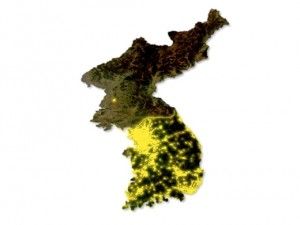 What we have there is a counterproductive cold war paradigm client state face-off. For decades, when cast as a confrontation between east and west, tension between north and south had a basis. There is no natural division between the Siamese-twin Koreas; neither physical, tribal, linguistic, nor spiritual.
What we have there is a counterproductive cold war paradigm client state face-off. For decades, when cast as a confrontation between east and west, tension between north and south had a basis. There is no natural division between the Siamese-twin Koreas; neither physical, tribal, linguistic, nor spiritual.
Those with experience on the Korean peninsula have perspectives shaped by their own when and why. Though there are still times of acute tension, the level of chronic anxiety has diminished with the changes in the relationships between the sponsor states. For some time, the sponsors (except for a brief and short-sighted thrust by Bush II) have considered the breaches of peace irritatingly counterproductive. In the big scheme of things, there is nothing in Korea to justify the sponsors expending national treasure and blood. For the Koreans, it is not much of a different story, though those south of the DMZ stand to lose more.
The Koreans understand this. They and their sponsors have written a variety of mutating scripts for the violent resumption of hostilities. The plans for the fighting remain variations on similar themes. The plans for intrigue are much more revealing. On both sides, there is a civil affairs design that works whether implemented as a result of war or of internal collapse. It is the more important plan.
This was a civil war thrust upon a people already reeling from years of occupation and dislocation. Civilians fled south in front of and in the wake of a marauding horde separating extended families and forcing the dismembered units to choose sides by accident of proximity and location. The tide changed and the bedlam increased with a sweep north that eventually stalled and reversed again. When the dust settled, Korean faced off against Korean doing the bidding of non-Koreans.
At armistice, no Korean was certain who to trust. There had been no time to mend after the Japanese occupation. Family was a tie that bound. The two countries were an artificial construct. Nation was incongruous with country. Family and nation could not be separated by the artificial boundary.
Dealing with South Korean counterparts, I came to understand that many had ties to the North and visa versa. That DMZ never completely stopped communication or commerce between Koreans. I suspect that is why martial law in its various forms lasted so long after the cessation of hostilities.
My first visit to Korea was during a period of high tension. The third tunnel had been discovered, we were mobilized, and traveled there from Okinawa with our Viet Nam War vintage equipment to join our US Army and Korean counterparts. That perspective was much different than the one I enjoyed two decades later working on operational level war plans informed by the completely broken strategic concept of Bush II and/or Rumsfeld. The “We go together” slogan/mantra of the fighting forces in the south came to have unsettling interpretations. To this day I am not sure who will go together with whom when the DMZ melts.
My sources are not classified materials or any formal plans. I was never involved in the South Korean civil affairs planning. They are the anecdotal ramblings at traditional drinking and entertainment venues after hours. They are observations from rudimentary counter-intelligence techniques. Fusing those sources, a complex picture of the relationship develops. Both sides infiltrated each other from day one. That was simple. Sneak across, under, or around the DMZ, find family members and co-opt them. The tunnels under the DMZ, there is no good count of them, belied the status quo of the ground force posture. The Northerners transited between the two countries carrying with them all forms of commerce. Eventually both sides had contacts in many cities and towns; enough so that formal appointments were made for positions of mayor and in the constabulary, though the South’s titular appointees more often continued living in the South.
When I went into the 7-11 in Seoul, I came to wonder if the clerk was really from the north and possibly the prospective mayor in the event of northern hegemony. And when I sat with a counterpart at the planning desk and answered an operational query not connected to our efforts, I wondered if the bizarre but credible answer I gave made its way to Pyongyang and caused head scratching before close of business.
All this to say that the most dangerous aspect of what happens when the North melts into the South in any manner is who holds the nuclear bombs and materials at the end of that day. There are plenty of plans for everything else. This is the most important plan. The Koreans do not want to destroy each other and the Chinese and Americans don’t want to come to blows over what began as and has devolved into a family feud. But the consequences for everyone else are dire: a unified nuclear Korea isn’t a pleasant prospect for Japan; nuclear weapons and material on the world market; Chinese and American ground forces facing off at the northern border or inside a collapsed North; and the same kind of cross border infiltration intrigue renewing itself at the Yalu with different clients.





![[UPDATED with Jim Ryan’s Letter] In Response to Youngkin’s “Sad, Whiny” Letter to Spanberger About UVA, VA Senate Majority Leader Surovell Says He’s “truly embarrassed for Gov Youngkin…After 4 yrs he has no understanding of basic VA govt structure”](https://bluevirginia.us/wp-content/uploads/2025/11/youngkinspanuva3-238x178.jpg)







![[UPDATED with Jim Ryan’s Letter] In Response to Youngkin’s “Sad, Whiny” Letter to Spanberger About UVA, VA Senate Majority Leader Surovell Says He’s “truly embarrassed for Gov Youngkin…After 4 yrs he has no understanding of basic VA govt structure”](https://bluevirginia.us/wp-content/uploads/2025/11/youngkinspanuva3-100x75.jpg)